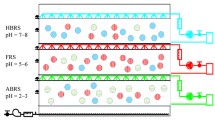Abstract
Biological deodorization of dimethyl sulfide (DMS) was studied using nine unwoven fabrics as the carriers of microorganisms in a laboratory-scale deodorizing system. The activated carbon fabric FN-200CF-15 was the best packing material compared with other packing materials used, on the basis of removal rate. The maximum removal rate (Vm), evaluated by using Michaelis-Menten equation, was 2.28 g-Skg-dry fab.-1 day-1 in this fabric biofilter. The critical load of DMS in this fabric biofilter was dependent on space velocity (SV), determined as 0.78 and 0.66 g-Skg-dry fab.-1 at SV 100 and 150 h-1, respectively.
Strain IM1 isolated from the carbon fabric FN-200CF-15 biofilter in modified Waksman (MW) medium successfully degraded DMS as well as hydrogen sulfide (H2S), methanethiol (MT), and dimethyl disulfide (DMDS) in batch test. The DMS removal rates (g-S cell-1h-1) by this strain measured in batch culture and calculated in FN-200CF-15 biofilter by the cell numbers appeared in MW medium were found almost equal, indicating that strain IM1 may be the dominant microorganism in this biofilter.
Similar content being viewed by others
References
Hirai, M., Terasawa, M., Inamura, I., Fujie, K., Shoda, M., and Kubota, H. (1988),J. Odor Res. Eng. 19, 305.
Hirai, M., Ohtake, M., and Shoda, M. (1990),J. Ferment. Bioeng. 70, 334.
Cho, K. S., Hirai, M., and Shoda, M. (1991),J. Ferment. Bioeng. 71, 289.
Zhang, L., Suzuki, M., Terasawa, M., Hirai, M., and Shoda, M. (1990),J. Odor Res. Eng. 21, 1.
Lee, S. K. and Shoda, M. (1989),J. Ferment. Bioeng. 68, 437.
Shibata, T. (1990), Investigation of fabric carriers for biological deodorization, Master’s dissertation, Tokyo Institute of Technology, Japan.
Urano, K. (1975),Surface 13, 738.
Cho, K. S., Zhang, L., Hirai, M., and Shoda, M. (1991),J. Ferment. Bioeng. 71, 44.
Kanagawa, T. and Kelly, D. P. (1986),FEMS Microbiol. Lett. 34, 13.
Smith, N. A. and Kelly, D. P. (1988),J. Gen. Microbiol. 134, 1407.
Kanagawa, T. and Mikami, E. (1989),Appl. Environ. Microbiol. 55, 555.
De Bont, J. A. M., Van Dijken, J. P., and Harder, W. (1981),J. Gen. Microbiol. 127, 315.
Suylen, G. M. H. and Kuenen, J. G. (1986),Antonie van Leeuwenhoek 52, 281.
Author information
Authors and Affiliations
Rights and permissions
About this article
Cite this article
Tiwaree, R.S., Cho, Ks., Hirai, M. et al. Biological deodorization of dimethyl sulfide using different fabrics as the carriers of microorganisms. Appl Biochem Biotechnol 32, 135–148 (1992). https://doi.org/10.1007/BF02922154
Received:
Accepted:
Issue Date:
DOI: https://doi.org/10.1007/BF02922154




